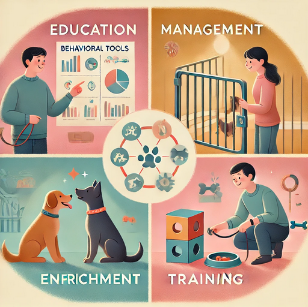Dog Training vs. Behavioral Consulting: What's the Difference?
Dog trainers and behavioral consultants often work toward similar goals—helping dogs and their owners live better lives together—but they do so in different ways. The key difference lies in the challenges they address and the tools they use. While trainers focus on teaching specific behaviors, consultants tackle deeper emotional or psychological issues using a broader set of strategies.*
Here are six key differences between dog training and behavioral consulting to help you know which professional might be best for your particular situation:
1. Primary Focus
Dog Trainers: Teach specific skills and manners, like sitting, staying, or leash walking. Their work revolves around helping dogs learn how to behave appropriately in everyday situations.
Behavioral Consultants: Address the root causes of problematic behaviors like fear, aggression, or anxiety. They aim to change not just what a dog does, but how they feel about their environment.
2. Tools of the Trade
Behavioral consultants rely on four main tools to create lasting change:
Education: Helping owners understand why their dog behaves a certain way and what factors influence those behaviors.
Management: Setting up the environment to prevent unwanted behaviors and reduce stress.
Enrichment: Providing mental and physical stimulation to meet a dog’s natural needs and reduce frustration.
Training: Teaching new behaviors, often overlapping with the work of trainers, to build useful skills and strengthen the bond between dog and owner.
Trainers focus primarily on the "training" component, while consultants integrate all four tools into their plans.
3. Behavior vs. Emotion
Dog Trainers: Focus on teaching actions and behaviors—what the dog does.
Behavioral Consultants: Focus on the emotions behind the actions, addressing the "why" behind behaviors like barking, lunging, or destructiveness.
4. Types of Challenges Addressed
Dog Trainers: Ideal for teaching life skills, basic manners, or performance tasks like agility.
Behavioral Consultants: Necessary for complex issues like reactivity, resource guarding, or separation anxiety, which require addressing emotional states.
5. Approach to Solutions
Dog Trainers: Use positive reinforcement and repetition to teach desired behaviors.
Behavioral Consultants: Combine training with strategies like desensitization, counter-conditioning, and management to modify emotional responses and prevent triggers.
6. Long-Term Goals
Dog Trainers: Aim for reliable, polished skills that make daily life easier.
Behavioral Consultants: Seek to improve the dog’s overall emotional well-being and repair the human-dog relationship.
Choosing between a trainer and a consultant depends on your dog’s needs. If your goal is teaching new skills, a trainer is the way to go. If your dog is struggling with emotional challenges, a behavioral consultant’s comprehensive approach can offer deeper support. In many cases, combining the two is the best way to ensure success and foster a harmonious life with your dog.
*An important note: The field of canine behavior is completely unregulated in the USA, meaning professionals are free to use any title they choose—from trainer to behaviorist—regardless of expertise or certification. When choosing a canine professional, be sure to carefully assess their qualifications and approaches before hiring.



